- A Study of the Painting by Leonardo Da Vinci
The Last Supper is a painting painted between 1496 to 1498 by Leonardo Da Vinci in the refectory of the Dominican convent of Santa Maria delle Grazie. The painting was made using experimental pigments directly on the dry plaster wall and unlike frescos, where the pigments are mixed with the wet plaster, it has not stood the test of time well. Even before it was finished there were problems with the paint flaking from the wall and Leonardo had to repair it. Over the years it has crumbled, been vandalized bombed and restored. Today we are probably looking at very little of the original.
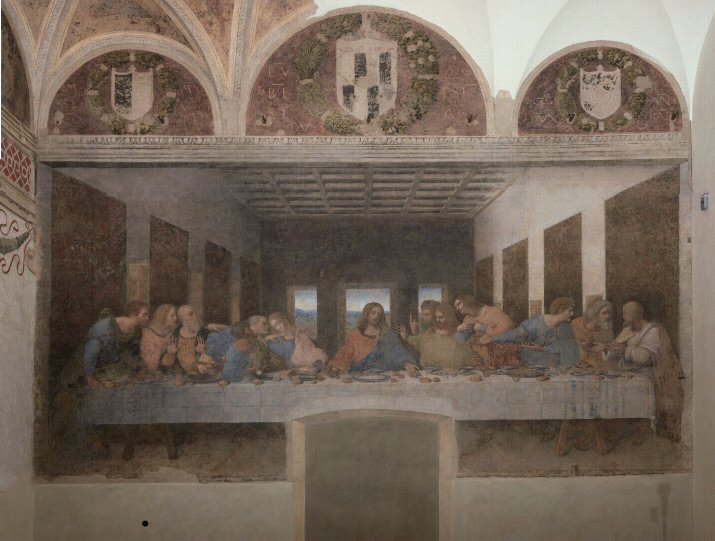
There are a number of points of interest:
Was it a 'Passover'?
Definitely not! The meal was set the day before 'Good Friday' - the day Jesus was crucified. The feast of the Passover began at sunset on that day so this meal was a day too early and, looking out the windows in the background, too early in the day. Also the picture shows Jesus and the disciples seated. The passover is traditionally eaten reclining. If you read your bible you will find:Matthew 26.2 "You know that after two days the Passover is coming, and the Son of man will be delivered up to be crucified." 26.3 Then the chief priests and the elders of the people gathered in the palace of the high priest, who was called Ca'iaphas, 26.4 and took counsel together in order to arrest Jesus by stealth and kill him. 26.5 But they said, "Not during the feast, lest there be a tumult among the people."
John 13.1 Now before the feast of the Passover, when Jesus knew that his hour had come to depart out of this world to...
The food
The table shows leavened bread (yet another reason it could not be the Passover), fish, wine and some type of herb present. To me there also appears to be cheese present. There is no sign of lamb which would traditionally have been eaten at the passover.The Cups/Glasses/Wine/Plates
There are twelve glasses shown to be present, each containing a red wine. It would be normal to drink wine with the meal - water was often contaminated. The glasses were odd however. Glass was popular with the Romans of the time but the conservative Jews would have drunk from goblets made from clay or wood. Only the wealthy would have drunk from metal goblets. The same is true of metal plates, several of which are shown. There's no pitcher or jug shown from which the glasses could have been refilled. There is a small, apparently empty, glass bottle, but this is too small to have contained the wine needed.The instant depicted
This is supposed to be the moment when Jesus, in the words of John says "Truly, truly, I say to you, one of you will betray me". The picture shows the reaction of the disciples to this.What's that bit centre bottom?
Around 1652, some unknown vandal decided to insert another door into the refectory and apparently decided that the only logical spot for it was smack in the middle of that wall where Leonardo had painted Christ's feet. The only evidence we have of what the original painting looked like was an oil paint copy made in the 16th centaury and now housed in Tongerlo Abbey , Antwerp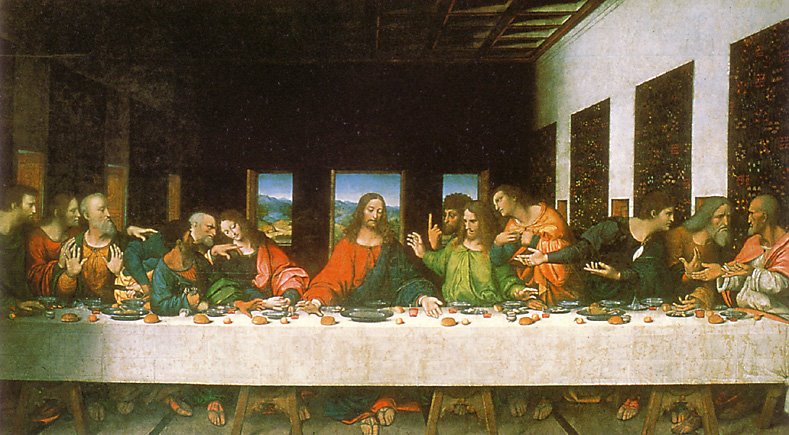
Just to complicate matters there's also a different version of the picture in a tapestry shown below:
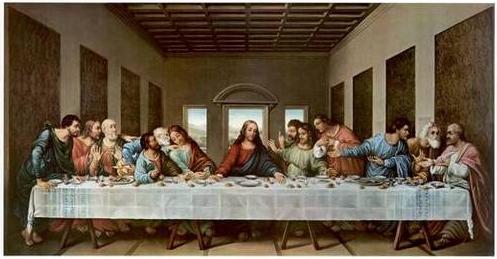
The Knife
Due to it's poor condition there has been some argument about
the owner of the hand holding the knife (or, as some call it, - a dagger):

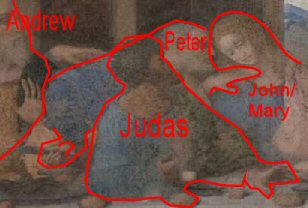
The theories are:
the owner of the hand holding the knife (or, as some call it, - a dagger):


The theories are:
- The hand belongs to John/Mary (whoever you choose to believe they are). Peter is holding his/her wrist. Andrew, who sees this, is horrified at this.
- The hand belongs to a separate, obscured person, probably John, with Mary shown at the right.
- The hand holding the knife belongs to Peter - he has it twisted backwards away from Judas
- Here's an image which has been doctored to remove Judas. Notice anything odd?

If that knife is being held by John/Mary then he/she has arms like a gorilla! Would Leonardo have made a mistake like this? There's also the evidence of John/Mary's fingers intertwined in front of him/her!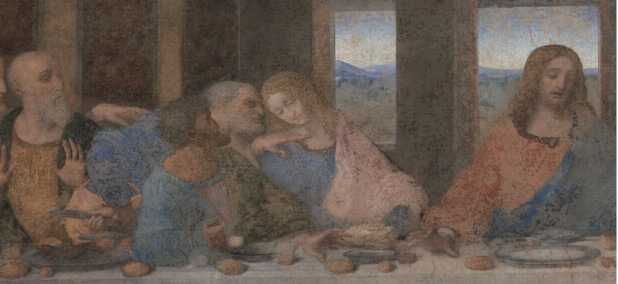
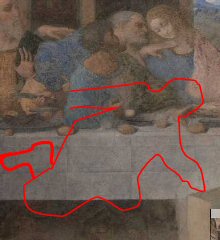 This suggestion assumes that the feminine figure at the right in the image is Mary Magdalene. In that case John, the youngest of the disciples is missing. The idea is that the hand belongs to John who is obscured by Peter and
This suggestion assumes that the feminine figure at the right in the image is Mary Magdalene. In that case John, the youngest of the disciples is missing. The idea is that the hand belongs to John who is obscured by Peter and
Judas. I find this very unlikely. If it were true - where exactly would John be?
Maybe he dropped his glass?
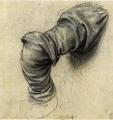 The last suggestion is that Peter is holding the knife at a very odd angle. The 'copies' suggest that this is the case and so too does this sketch by Leonardo - clearly that knife in the hand of Peter gave him some problems and he decided to practice.
The last suggestion is that Peter is holding the knife at a very odd angle. The 'copies' suggest that this is the case and so too does this sketch by Leonardo - clearly that knife in the hand of Peter gave him some problems and he decided to practice.
John or Mary Magdalene?
In the fictional book 'The Da Vinci Code', Daniel Brown has his character Teabing suggest that the figure seated to Jesus' right is not the disciple John but is instead Mary Magdalene. The theory, suggested several times in the past, is that Jesus married Mary and after the crucifixion she had a child by him.I must admit that to my eye 'John' does look very effeminate. But is that enough evidence for the figure being Mary? We need to consider the following:
- Would the Church of the time have allowed this?

- It was 'normal' at the time for a young man, and John was the youngest of the disciples, to be portrayed
as effeminate. Not only Leonardo did this. - Leonardo is suspected to have been a homosexual.
- If 'John' is 'Mary' then where is John? Hiding under the table?
- Is that a necklace around 'John's' neck? If so - whatever happened to 'go, sell what you possess and give to the poor'. However no fewer than six others in the painting have a similar item, possibly a garment fastener.
- In 'The Da Vinci Code' Teabing refers to 'delicate folded hands, and the hint of a bosom'. Sorry - I don't see either! John's hands don't look feminine and to see a 'bosom' you need a great deal of imagination.
Who is where in the picture?

The evidence for this comes from a contemporary document discovered in 1800 which gives the names of each person in the picture.
The grouping
Looking across the picture from left to right the disciples are shown in four groups of three:- Bartholomew, James Minor and Andrew form a group of three. All are horrified, Andrew to the point of holding his hands up in a "let's calm down " gesture.
- Judas, Peter and John form the next group of three. Judas has his face in shadow and
is clutching a small bag, presumably money. He was quite often portrayed with this in last supper paintings. He is also reaching for bread at the same time as Jesus is. Peter, in the fashion of the time, is shown clutching a knife and, with his hand on John's shoulder, is asking a feminine-looking John "Who does he say it is?". John leans toward him to hear what he says creating a V shape between himself and Jesus which has been interpreted by some as an indication of a marriage between 'Mary' and Jesus. - Christ is very much the calm person alone in the midst of the debate.
- Thomas, James the Elder and Philip are next. 'Doubting' Thomas is pointing upward, maybe asking for one shred of evidence that this is so. His other hand is on the table between James and Philip as though seeking something solid. James the Elder looks stunned and seems to be watching Jesus' left hand. Philip seems to be asking 'Is it me?'.
- Matthew, Thaddeus and Simon comprise the last group of three figures. Matthew and Thaddeus seem to be asking Simon about Jesus' statement.
The time
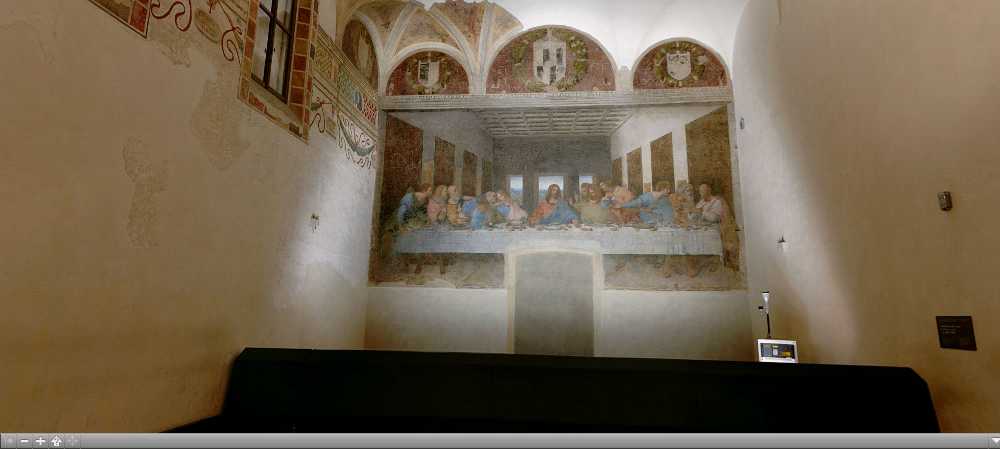
Incidentally did you know that there are over 400,000 pages refering to this painting of which 50,000 also refer to Daniel Brown's book 'The Da Vinci Code'? 1750 entries also refer to an earlier book 'The Templar Revelation: Secret Guardians of the True Identity of Christ'
by written by Lynn Picknett and Clive Prince in 1997. 750 refer to an even earlier book Holy Blood, Holy Grail by Michael Baigent, Richard Leigh and Henry Lincoln (Even Daniel Brown refers to this book within his story and the character 'Leigh Teabing' seems to be a combination of 'Richard Leigh' and an anagram of 'Baigent')
by written by Lynn Picknett and Clive Prince in 1997. 750 refer to an even earlier book Holy Blood, Holy Grail by Michael Baigent, Richard Leigh and Henry Lincoln (Even Daniel Brown refers to this book within his story and the character 'Leigh Teabing' seems to be a combination of 'Richard Leigh' and an anagram of 'Baigent')